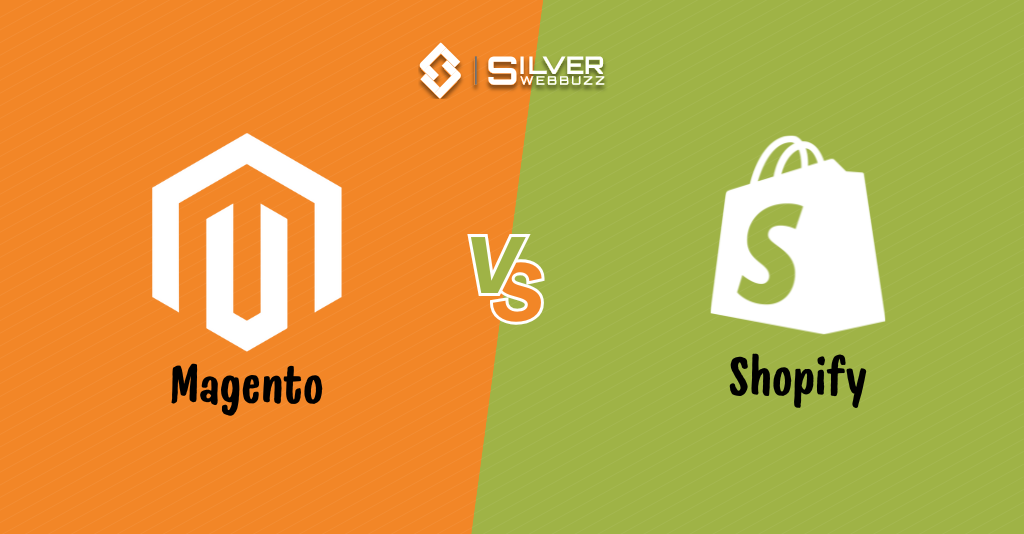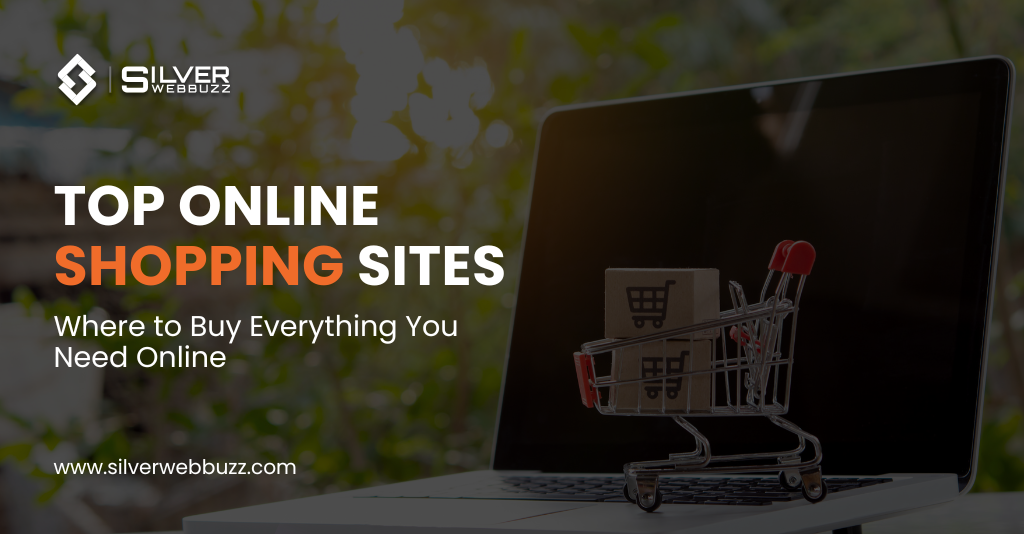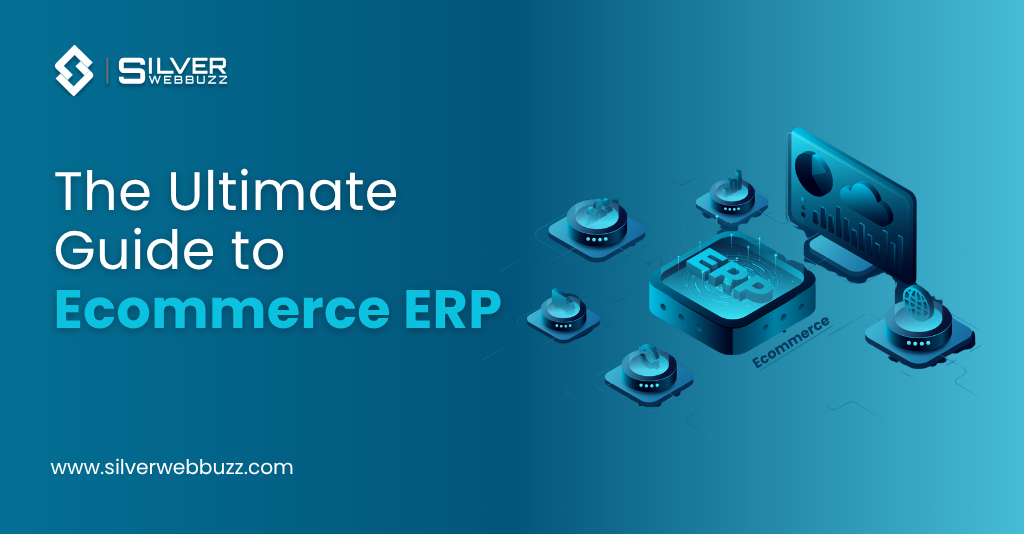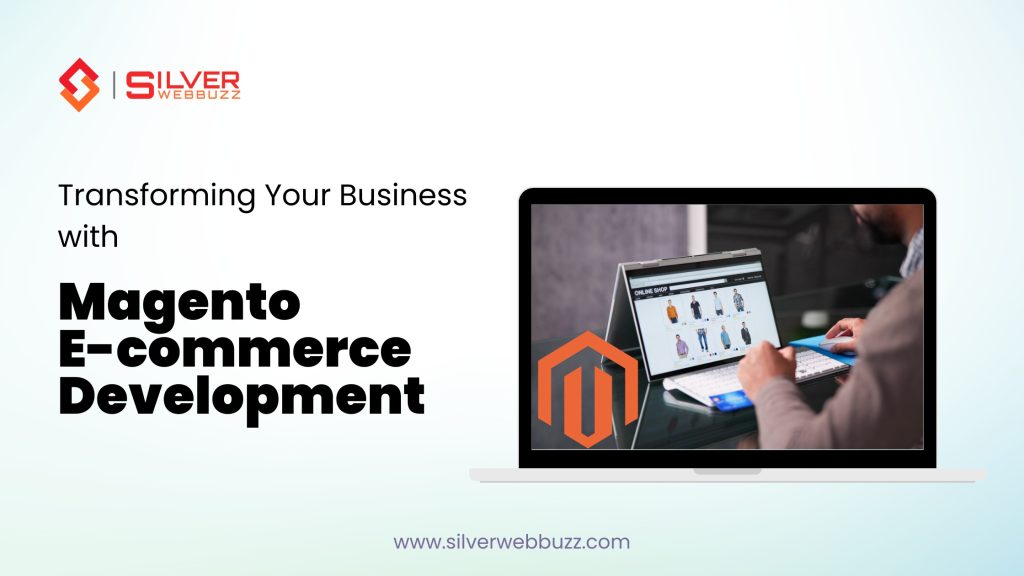Choosing your eCommerce platform is like laying the foundation for a skyscraper. Get it right, and you have a stable base for massive growth. Get it wrong, and you’ll face costly cracks and limitations down the line. In the booming world of online retail, two names tower above the rest: Magento (now Adobe Commerce) and Shopify.
But which titan of eCommerce is the right choice for your business?
This is the ultimate question for countless entrepreneurs and established businesses alike. People search for answers using terms like “Shopify vs Magento”, “Adobe Commerce vs Shopify,” and “best eCommerce platform,” all seeking clarity.
This guide will provide that clarity. We will dissect every critical aspect of these two platforms—from pricing and performance to SEO andscalability. By the end, you’ll have a clear, confident answer and a roadmap for your eCommerce growth strategy.
Key Takeaways: Magento vs. Shopify at a Glance
Choose Shopify if: You are a beginner, a small-to-medium business (SME), or a dropshipper who needs an all-in-one, easy-to-use platform to launch quickly. It’s built for simplicity and predictable costs.
Choose Magento if: You are a large, established enterprise, a B2B company, or a fast-growing business with complex needs that require ultimate customization, scalability, and control over your code and hosting.
Core Difference: Shopify is a SaaS (Software-as-a-Service) product where you pay a monthly fee for software, hosting, and support in one package. Magento is an open-source platform, giving you the code for free (Magento Open Source) or via a license (Adobe Commerce), but you must manage your own hosting, security, and development.
Cost Reality: Shopify’s costs are predictable monthly subscriptions. Magento’s total cost is highly variable and includes hosting, developer fees, theme/extension costs, and potential licensing fees, making the Magento website cost significantly higher upfront.
What is Magento (Adobe Commerce)?
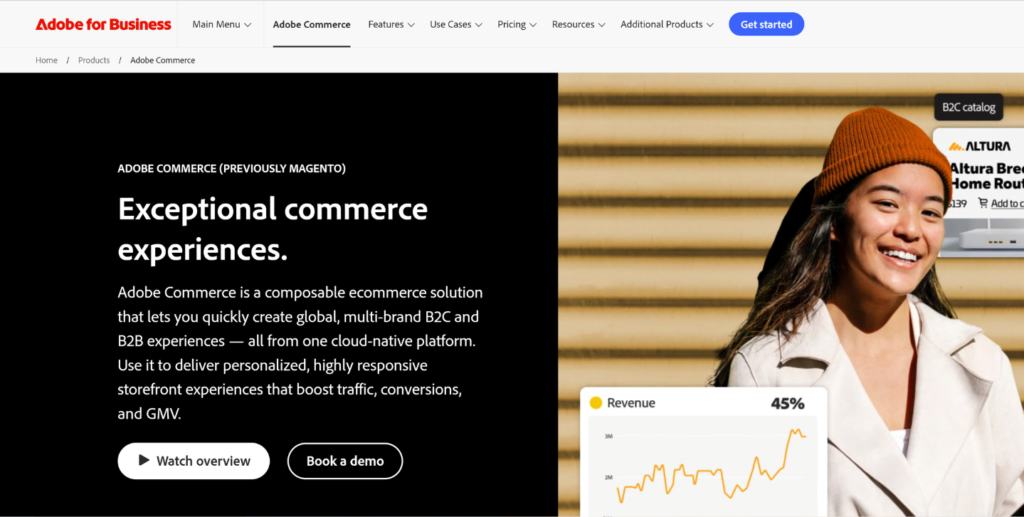
Magento is a powerhouse open-source eCommerce platform renowned for its unparalleled flexibility and scalability. Acquired by Adobe in 2018, it now exists in two primary forms:
Magento Open Source: This is the free, community-supported version. You can download the source code and build a store from the ground up, but you are responsible for everything: hosting, security, development, and maintenance.
Adobe Commerce (formerly Magento Commerce): This is the premium, enterprise-level version. It includes advanced features for B2B, cloud hosting options, and dedicated support from Adobe. The Magento enterprise cost is substantial, tailored for large corporations.
Magento is the choice for businesses that refuse to be put in a box. Its key strengths include:
Limitless Customization: With full access to the source code, developers can build virtually any feature or integration imaginable.
Powerful Scalability: It’s designed to handle massive product catalogs (hundreds of thousands of SKUs), high traffic volumes, and complex multi-store, multi-language, and multi-currency setups.
Robust B2B Features: Adobe Commerce offers out-of-the-box functionalities like custom catalogs, company-specific pricing, and quote management.
The initial Magento website cost and ongoing Magento hosting cost are significant considerations, as it requires a dedicated development team or agency to manage effectively.
What is Shopify?

Shopify is a cloud-based, all-in-one eCommerce platform that has taken the world by storm with its simplicity and user-friendliness. Unlike Magento, you don’t need to worry about hosting or server maintenance—it’s all included in your monthly subscription.
Shopify is the go-to platform for beginners, dropshippers, and small-to-medium businesses (SMEs) looking for a fast and easy way to get online. The process of how to start a Shopify store is famously straightforward.
Key features that make Shopify so popular include:
Ease of Use: A clean, intuitive dashboard and a drag-and-drop theme editor make building and managing a store accessible to non-technical users.
All-in-One Solution: Your subscription covers software, high-performance hosting, security, and 24/7 customer support.
Massive App Store: Easily add new functionality to your store with thousands of one-click-install apps for marketing, shipping, inventory, and more.
The main question for new users is how much does Shopify cost?, which we’ll break down next. While incredibly powerful, its customization is limited compared to Magento, as you don’t have access to the backend code.
Magento vs Shopify: What Sets Them Apart?
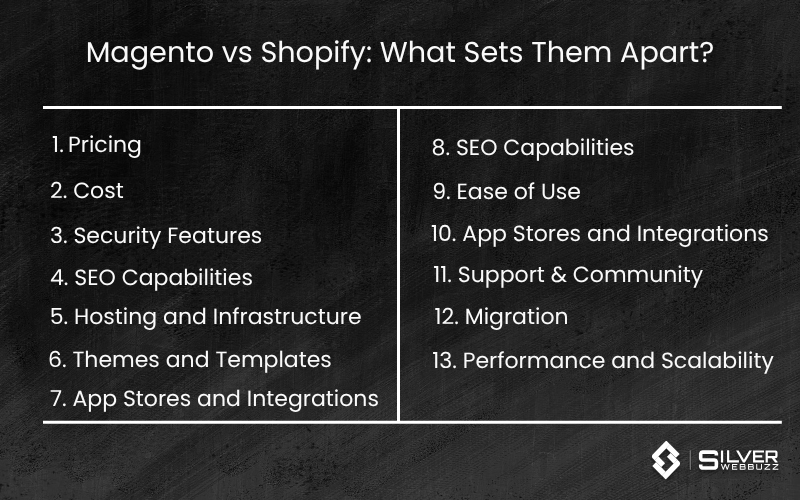
There are the key Differences:
Pricing: Magento Commerce Pricing vs Shopify
This is often the most decisive factor. The two platforms have fundamentally different pricing models.
Magento Pricing Breakdown
Magento’s costs are multifaceted.
1. Magento Open Source: The software itself is free. However, the “free” label is misleading. You must pay for:
- Magento Hosting Cost: This can range from $20/month for basic shared hosting to over $1,000/month for dedicated cloud infrastructure, depending on your store’s size and traffic.
- Development Costs: You will need a developer or agency. Building a custom Magento site can cost anywhere from $10,000 to $250,000+, depending on complexity.
- Themes & Extensions: Premium themes cost 50−200, and extensions can range from free to thousands of dollars.
- Maintenance: Budget for ongoing security patches, updates, and support.
2. Adobe Commerce (Enterprise) Pricing: This is license-based and priced according to your Gross Merchandise Volume (GMV). Magento Commerce pricing typically starts around $22,000 per year and can exceed $100,000 for large enterprises. This fee is in addition to hosting and development costs.
Shopify Pricing Breakdown
Shopify’s pricing is transparent and predictable.
- Basic Shopify: ~$29/month. Ideal for new businesses.
- Shopify: ~$79/month. Best for growing businesses that need more staff accounts and better reporting.
- Advanced Shopify: ~$299/month. For scaling businesses that require advanced reporting and lower transaction fees.
- Shopify Plus: Starts around $2,000/month. This is Shopify’s enterprise solution, offering more customization, dedicated support, and higher API limits to compete with Adobe Commerce.
Transaction fees also apply unless you use Shopify Payments.
Cost Comparison Chart
| Feature | Magento (Open Source) | Adobe Commerce | Shopify (Standard Plans) |
|---|---|---|---|
| Software Cost | Free | $22,000+/year | $29 – $299/month |
| Hosting | Variable ($20 – $1,000+/mo) | Included in License or 3rd Party | Included |
| Development | High (Required) | Very High (Required) | None (Included) |
| Maintenance | High (User’s Responsibility) | High (User’s Responsibility) | Low (DIY friendly) |
| Best For | Tech-savvy SMEs, custom projects | Large Enterprises, B2B | Startups, SMEs, D2C Brands |
Hosting and Infrastructure
Magento requires you to source your own hosting. This gives you full control but also full responsibility. You can choose from shared hosting (not recommended for serious stores), VPS, or dedicated cloud providers like AWS or Google Cloud. A higher Magento hosting cost typically translates to better performance and security.
Shopify, being a fully hosted platform, handles all of this for you. Their infrastructure is built for eCommerce, providing excellent uptime, fast load times, and a global CDN (Content Delivery Network) to ensure your store is fast for customers everywhere. You never have to worry about server patches or managing traffic spikes during a flash sale—Shopify handles it all.
Security Features
Security is non-negotiable in eCommerce.
Shopify takes care of security for you. All Shopify stores are Level 1 PCI DSS compliant by default, and they provide a free SSL certificate. They manage security patches and threat detection behind the scenes, so you can focus on selling.
With Magento, security is your responsibility. While the platform is inherently secure, you must ensure your hosting environment is configured correctly, install SSL certificates, and—most importantly—diligently apply security patches as soon as they are released. This often requires developer assistance. While it offers more control, it also carries more risk if not managed properly.
For most businesses, Shopify is the safer choice as it removes the potential for human error in security management.
SEO Capabilities: Magento vs Shopify
Both platforms are strong for SEO, but they approach it differently.
Magento offers arguably the most powerful and granular SEO controls out of the box. You can customize URL structures, manage canonical tags, implement rich snippets, edit robots.txt, and optimize metadata with complete freedom. This makes it a dream for technical SEOs looking to squeeze every drop of performance from their site.
Shopify has excellent built-in SEO features that cover all the essentials for most businesses. It automates sitemaps, allows for metadata editing, and has a clean code base. However, its URL structure is somewhat rigid (e.g., /products/ and /collections/ cannot be removed), which can be a minor frustration for SEO purists. Most limitations can be overcome with apps from the Shopify App Store.
Which supports a better eCommerce growth strategy via SEO? For 95% of businesses, Shopify’s SEO capabilities are more than enough. For enterprises with a dedicated SEO team that needs absolute control, Magento has the edge.
Themes and Templates
Shopify boasts a large Theme Store with dozens of beautiful, mobile-responsive free and premium templates (typically
180−350). These themes are easy to customize with the drag-and-drop editor, allowing you to create a professional-looking store in hours.
Magento’s marketplace (Adobe Commerce Marketplace) also offers themes, but the selection is smaller. The real power of Magento lies in custom theme development. Businesses often hire agencies to build a completely unique, branded user experience from scratch. This offers ultimate flexibility but is significantly more expensive and time-consuming.
Ease of Use
This is the clearest point of differentiation.
Shopify is the undisputed winner in ease of use. Its interface is designed for absolute beginners. Adding products, managing orders, and changing your site’s design is intuitive and requires no coding knowledge.
Magento has a very steep learning curve. The admin panel is complex and powerful, reflecting its enterprise focus. It is not designed for business owners to manage themselves without prior technical experience or extensive training. It is a developer-friendly platform.
App Stores and Integrations
Both platforms have robust app marketplaces to extend functionality.
The Shopify App Store is famous for its vast selection of over 8,000 apps. You can find a plug-and-play solution for almost anything: email marketing (Klaviyo), loyalty programs, advanced shipping rules, and more. Most apps are easy to install and work seamlessly.
The Magento Marketplace offers thousands of powerful extensions. These often provide deeper, more complex functionality than Shopify apps, especially for B2B and backend operations like ERP integration. However, installing and configuring Magento extensions often requires developer help and can sometimes lead to conflicts with other extensions.
Support & Community
Shopify offers award-winning 24/7 support via live chat, email, and phone for all its paying customers. This direct line of help is invaluable, especially for beginners.
Magento Open Source has no official support. You must rely on its vast global community of developers through forums and documentation. For Adobe Commerce, you get dedicated, ticket-based support from Adobe’s expert team. A large network of Magento development companies and freelancers is also available for hire.
Migration: Shopify to Magento or Magento to Shopify
Businesses often migrate between platforms as their needs evolve.
Why migrate from Shopify to Magento? The primary reason is outgrowing Shopify’s customization limits. A business might need complex product configurations, multi-store architecture, or specific B2B features that only Magento can provide.
Why migrate from Magento to Shopify? Businesses often switch to escape the high maintenance costs, development dependencies, and technical complexity of Magento. Migrating to Shopify (especially Shopify Plus) can dramatically lower total cost of ownership and simplify day-to-day operations.
Migration is a complex process that involves moving products, customers, and order data. It is highly recommended to use a professional service from an experienced Magento development company or a Shopify development company to ensure a smooth transition.
Performance and Scalability
Shopify offers excellent, consistent performance for small to large businesses. It handles traffic spikes from marketing campaigns or flash sales automatically. Shopify Plus is built to handle enterprise-level traffic, as seen with brands like Gymshark and Fashion Nova.
Magento is built for extreme scalability. It can handle hundreds of thousands of products and millions of visitors, but this performance is directly tied to the quality of your hosting and code optimization. A poorly configured Magento store will be slow, while a professionally optimized one can outperform almost anything. It’s the platform of choice for businesses with massive, complex catalogs.
Customization and Development Flexibility
This is Magento’s core strength. With Magento, you have 100% access to the code. If you can dream it, a skilled developer can build it. This is essential for businesses with unique workflows, custom product types, or deep integrations with backend systems like an ERP or PIM.
Shopify’s customization is limited. You have great control over the “storefront” (the theme), but the backend and checkout process are largely locked down, except on Shopify Plus where you get more flexibility with checkout scripts and APIs. This “walled garden” approach ensures stability and security but limits what you can fundamentally change.
Expert Insight: When considering customization, think about your must-have features vs. your nice-to-have features. If your core business model relies on a feature that Shopify simply cannot support (e.g., a complex product configurator for B2B industrial parts), then Magento is your only viable path, despite the higher cost and complexity.
Mobile Responsiveness and Mobile Commerce
Both platforms excel at mobile commerce.
All modern Shopify themes are mobile-responsive by default. Shopify also offers a “Shop” app for a unified mobile shopping experience and a great mobile app for store owners to manage their business on the go.
Magento also supports responsive design themes. Furthermore, it offers powerful support for Progressive Web Apps (PWAs) through its PWA Studio. A PWA can provide an app-like experience in a mobile browser, leading to faster speeds and higher engagement.
How to Choose the Best eCommerce Platform
Still undecided? Use this checklist to find your perfect match. This is how to choose the best eCommerce platform for your specific situation.
1. Your Budget:
- Limited/Predictable Budget: Choose Shopify.
- Large/Flexible Budget: Consider Magento.
2. Your Business Size:
- Startup/SME: Choose Shopify.
- Large Enterprise: Consider both Adobe Commerce and Shopify Plus.
3. Your Technical Expertise:
- Beginner/Non-Technical: Choose Shopify.
- Have a Dev Team/Are a Developer: Consider Magento.
4. Your Scalability Needs:
- Standard Growth/Large Catalog: Shopify Plus can handle it.
- Massive/Complex Catalog, B2B, Multi-Store International: Choose Magento.
5. Your Time to Market:
- Need to Launch ASAP: Choose Shopify.
- Have a Longer Development Timeline: Consider Magento.
If you are still unsure, consulting with an agency that offers the best eCommerce development services can provide a tailored recommendation.
Real-World Examples and Case Studies
1. Brands Thriving on Shopify:
- Gymshark: A fitness apparel giant that scaled to a billion-dollar valuation on Shopify Plus.
- Allbirds: The popular sustainable footwear brand known for its simple, direct-to-consumer model.
- Kylie Cosmetics: A prime example of a brand leveraging Shopify’s ability to handle massive flash sales and hype-driven traffic.
2. Businesses Powered by Magento (Adobe Commerce):
- Coca-Cola: Uses Magento for complex merchandising and B2B ordering portals.
- HP (Hewlett-Packard): Relies on Magento for its global B2B and B2C sales infrastructure.
- Ford: Utilizes Magento for its accessories and merchandise online store, showcasing its ability to handle complex product catalogs.
eCommerce Growth Strategy Considerations
Your platform choice directly impacts your long-term growth.
- Multi-channel Selling: Both platforms integrate well with marketplaces like Amazon, eBay, and social media channels like Facebook and Instagram.
- Marketing & CRM: Shopify has seamless integrations with popular tools like Klaviyo and Mailchimp. Magento can integrate with anything, including enterprise-level CRMs like Salesforce, but it requires custom development.
- Long-Term ROI: Shopify’s lower total cost of ownership can provide a faster ROI for SMEs. Magento’s high initial investment can pay off massively for large enterprises by enabling complex, high-margin sales channels that wouldn’t be possible on a simpler platform.
Final Comparison Table: Magento vs Shopify
| Feature | Magento (Adobe Commerce) | Shopify (inc. Shopify Plus) |
|---|---|---|
| Pricing Model | Variable (License, Hosting, Dev) | Predictable (Monthly Subscription) |
| Hosting | Self-Hosted | Fully Hosted & Managed |
| SEO | Excellent (Full Control) | Excellent (Easy & Effective) |
| Ease of Use | Difficult (Steep Learning Curve) | Very Easy (Beginner-Friendly) |
| Themes | Custom Development Focus | Large Template Store |
| Customization | Unlimited (Full Code Access) | Limited (Theme & API-level) |
| Security | User’s Responsibility | Managed by Shopify |
| Support | Community Forums or Paid Support | 24/7 Included Support |
| Best For | Enterprises, B2B, Complex Stores | Startups, SMEs, D2C Brands |
Next Steps
You’ve done the research. Now it’s time to act.
- Ready for Shopify? You can how to start a Shopify store in a single afternoon. Sign up for their free trial and start exploring the platform today.
- Leaning towards Magento? Your first step is not software installation. It’s finding the right development partner. Start researching experienced Magento agencies and developers to discuss your project scope and get a realistic quote for your Magento website cost.
- Considering Migration? Whether moving to or from a platform, contact a specialized agency to ensure a seamless transition of your valuable data.
Additional Resources
- Shopify’s Free Trial and Setup Guides
- Official Adobe Commerce & Magento Open Source Documentation
- Shopify Plus Overview for Enterprise
- Cost Calculators: Explore the Magento enterprise cost vs. how much does Shopify cost for your specific revenue.
Conclusion: The Right Platform for Your Ambition
The “Magento vs Shopify” debate doesn’t have a single winner—only the right choice for a specific business.
Choose Shopify if your priority is speed to market, ease of use, and a predictable, all-in-one solution. It’s the perfect launchpad for startups, small businesses, and direct-to-consumer brands who want to focus on their products and marketing, not on server maintenance.
Choose Magento if your business has complex requirements, a large budget for custom development, and the need for ultimate control and scalability. It is the undisputed king of customization, making it the ideal platform for large enterprises, complex B2B operations, and brands with a unique vision that cannot be confined by templates.
Your eCommerce platform is the engine of your online business. Choose the one that not only fits you today but also has the power to take you where you want to go tomorrow.
Ready to build a powerful, growth-focused eCommerce store? Get started with the best experienced e-commerce development Services by Silver WebBuzz today.
